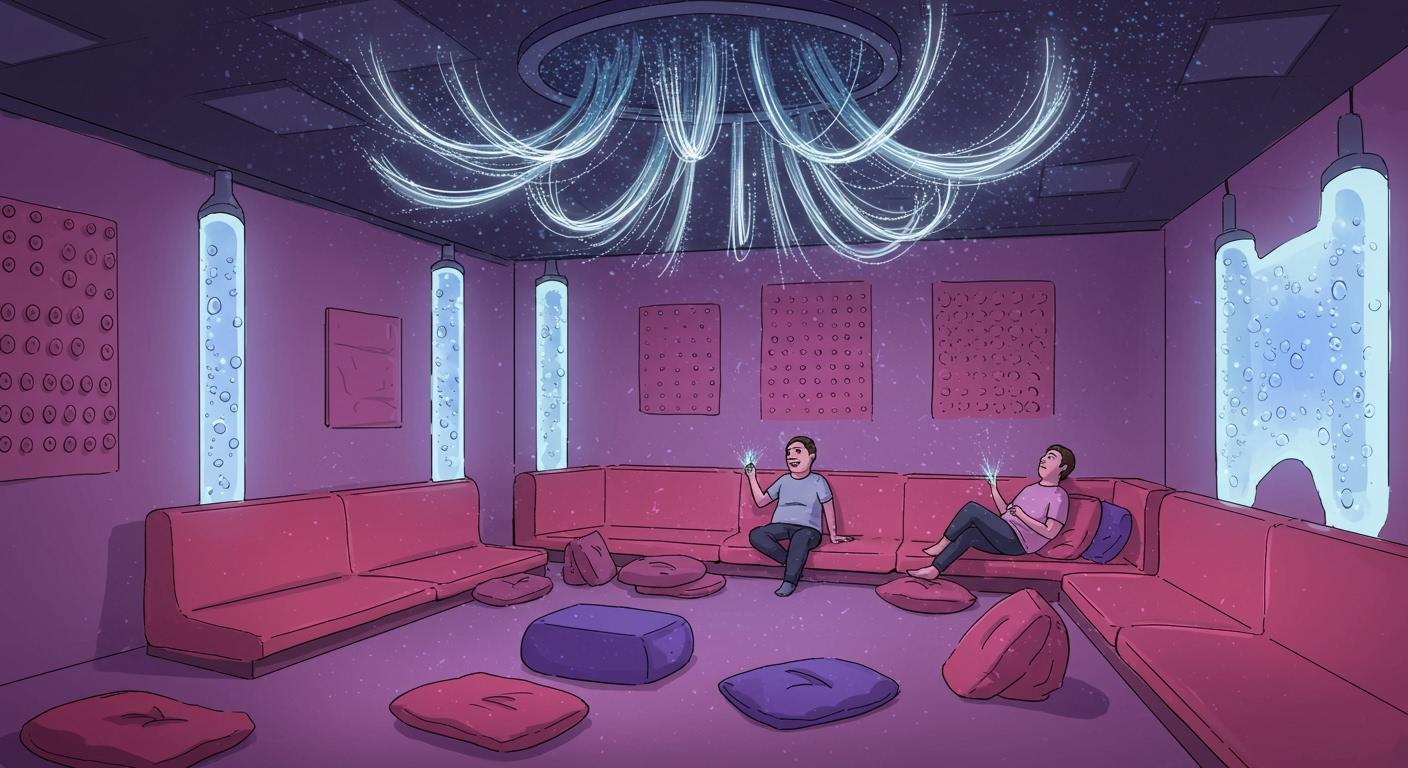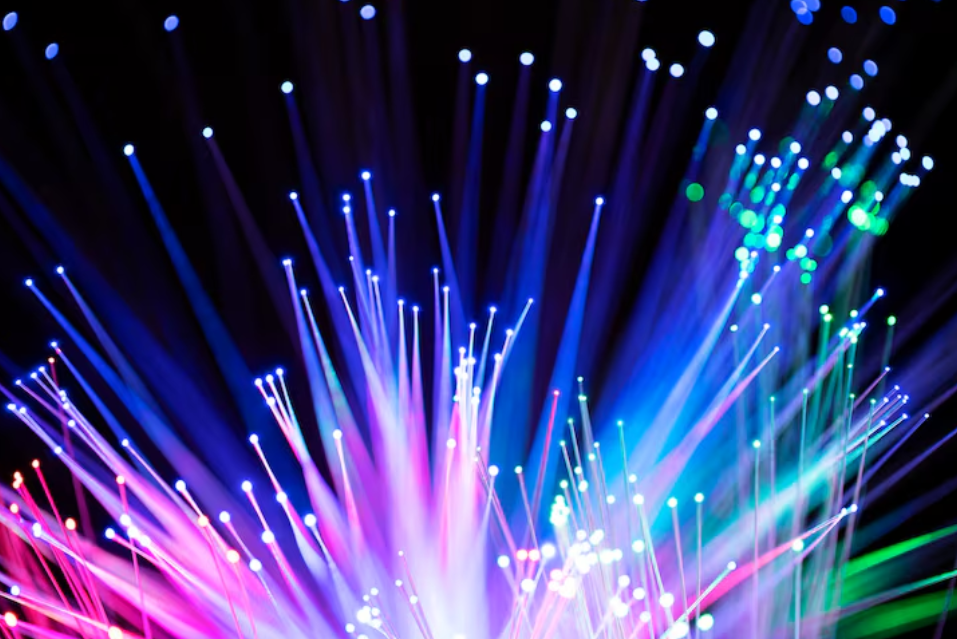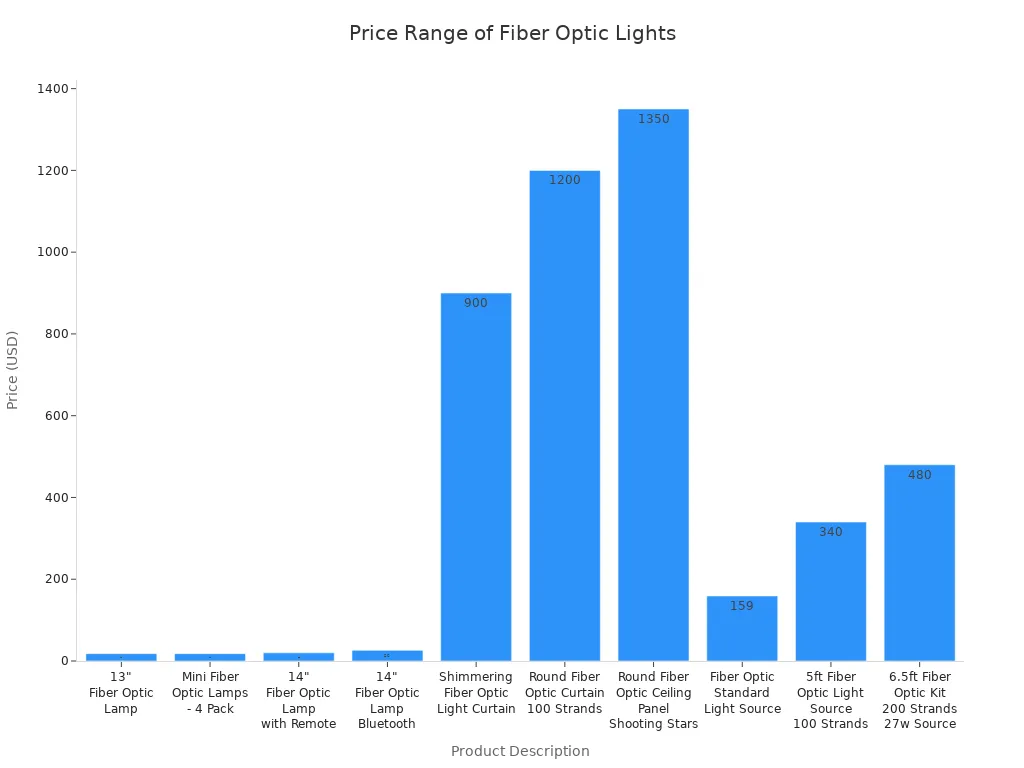Sensory room fiber optic lights for peaceful moments

You can make a calm space with sensory room fiber optic lights. These lights shine softly and do not hurt your eyes. This helps if bright lights bother you. Many kids with autism or sensory processing disorders feel relaxed when they see the colors change or touch the glowing strands. Studies show that good light and color can help mood and behavior. Choices like LED Fiber Optic Lights or a Starry Mat Fiber Optic Carpet give both things to look at and touch. Parents, caregivers, and teachers often notice kids feel calmer and join in more in these peaceful spaces.
Key Takeaways
Fiber optic lights help make a calm space. Their gentle light can lower stress and worry. This makes them great for sensory rooms.
These lights give both visual and touch stimulation. People can watch the colors change. They can also touch the strands. This helps people focus better. It also helps with small hand movements.
Safety is very important with fiber optic lights. They do not get hot. They do not carry electricity. This makes them safe for kids and people with special needs.
There are different kinds of fiber optic lights. Each type has its own good points. Curtains, strands, and tunnels can make sensory rooms better in different ways.
Using fiber optic lights with other sensory tools works well. You can use them with bubble tubes or soft mats. This makes the room more fun and interactive.
What are fiber optic lights?

How they work
Fiber optic lights use thin, flexible strands to carry light from a source to the ends of each strand. You see the light glow at the tips and along the sides. These strands do not get hot, so you can touch them safely. The lights often use LEDs, which shine bright colors through the fibers. You can watch the colors change or stay steady, depending on the setting.
Fiber optic lighting gives you soft, colorful strands that you can touch and move. This makes them perfect for sensory rooms, where you want both visual and tactile experiences.
You can find fiber optic lights in many shapes and sizes. Some look like sprays or waterfalls. Others form carpets or mats that you can sit or lie on. Each type creates a different sensory effect.
Forms and types
You have many options when choosing fiber optic lights for a sensory room. Each type offers unique benefits:
Type | Description | Benefits |
|---|---|---|
Strands | Portable lights you can drape over yourself or furniture | Mesmerizing colors, touch interaction |
Curtains | Hanging lights that create a wall of color and movement | Visual and tactile stimulation |
Tunnels | Enclosed spaces lined with glowing fibers | Immersive, interactive experience |
Fiber optic curtains give you a wall of moving lights. You can walk through them or sit nearby to watch the colors.
Fiber optic sensory lights come as bundles of strands. You can hold, twist, or run your fingers through them.
Tunnels and carpets create spaces where you feel surrounded by gentle light.
Fiber optic lights come in many variations. You can pick the one that fits your needs best. Some work better for calming, while others help with active play.
You can use these lights to create a peaceful, engaging space that supports sensory needs.
Sensory room benefits

Calming effects
Fiber optic lights help make your sensory room peaceful. Watching the soft glow and colors can help you relax. Many people feel less stress and worry with these lights. Studies show fiber optic sprays help people act more positively. For example:
Koller et al. (2018) saw more positive behaviors with fiber-optic sprays in multisensory rooms.
Singh et al. (2004) found that fiber optics with other tools lowered aggression and self-injury.
Soft lights can help you feel safe and calm. This is helpful if loud sounds or bright lights upset you. Fiber optic lights stay cool, so you can touch them safely. They are safer than many other sensory tools.
Tip: Try turning down the room lights and let fiber optic lights shine. You might notice your breathing slows and your muscles feel relaxed.
Visual and tactile stimulation
Fiber optic lights give you something to see and touch. The glowing strands change colors and move gently. This keeps your eyes interested. You can touch the strands, twist them, or lay them on your lap. Seeing and touching the lights helps your brain focus and stay calm.
Some things people like most are:
Watching colorful, moving lights
Feeling calm and less anxious
Fun light patterns that help you focus
Touching the strands to build fine motor skills
You can compare fiber optic lights to other sensory tools:
Fiber optic lights are calming and fun for your eyes and hands.
They are safer because they do not get hot or use open electricity.
Fiber optics make you want to touch and play with the lights.
They fill the room with color and help you relax.
Note: Sensory rooms with fiber optic lights help you learn colors and practice following moving things with your eyes.
Mood and engagement
Spending time with fiber optic lights can make you feel happier. The lights help you want to join in activities. Many people with special needs find it easier to take part when the room feels safe.
Fiber optic lighting helps you join in by:
Giving you things to see and touch
Making the room calm and relaxing
Helping you interact, which is good for people with special needs
Creating a safe and peaceful feeling
Giving quick relief from too much noise or light
Helping you learn colors and follow moving lights
Inviting you to explore and play
Building fine motor skills
Working well for people of all ages and abilities
Here is a table comparing sensory rooms with and without fiber optic lights:
Feature | Description |
|---|---|
Fiber optic lights make the room look interesting and are safe to use. | |
Calming yet stimulating | They help you feel calm but also keep your senses interested. |
You can see fiber optic lights help you feel calm and focused. They make you want to learn, relax, and join in activities.
Choosing fiber optic lights
Key features
When you pick fiber optic lights, look for safe and fun features. Many lights let you pick from 16 colors. You can choose a color that helps you feel calm or focused. Some lights have four lighting modes. You can pick steady, slow fade, or twinkle effects. These choices help you set the mood for relaxing or playing.
Here is a table with important features to think about:
Feature | Description |
|---|---|
Color Options | 16 distinct colors for customization |
Lighting Modes | 4 modes to create different ambiances |
Safety | No electricity or heat in fibers, safe to touch |
Therapeutic Benefits | Calming effects, supports sensory integration and relaxation |
Tip: Pick lights with simple remotes or switches. This way, you can change settings by yourself.
Safety and durability
Safety is very important, especially for kids or people with special needs. Fiber optic lights do not get hot. They do not carry electricity in the strands. This means you can touch and play with them safely. Look for lights tested by labs and certified for safety. Good lights use UL-certified parts.
Fiber optic strands follow safety rules.
Electronic parts are UL certified.
Always use these lights with an adult watching. Do not leave kids alone.
These lights last about 10,000 hours, so they work for a long time.
Note: Fiber optic sensory lights are cool to touch and safe for sensory rooms.
Price range
You can find fiber optic lights for different budgets. Small lamps cost about $18. Bigger things like curtains or ceiling panels can cost over $1,000. The price changes with size, features, and brand.
Product Description | Price |
|---|---|
13" Fiber Optic Lamp | |
Mini Fiber Optic Lamps - 4 Pack | $18.00 |
14" Fiber Optic Lamp with Remote | $20.00 |
14" Fiber Optic Lamp - Bluetooth Speaker | $26.00 |
Shimmering Fiber Optic Light Curtain (8 Colors) | $900.00 |
Round Fiber Optic Curtain - 100 Strands | $1,200.00 |
Round Fiber Optic Ceiling Panel with Shooting Stars | $1,350.00 |
Fiber Optic Standard Light Source | $159.00 |
5ft Fiber Optic Light Source - 100 Strands | $340.00 |
6.5ft Fiber Optic Kit - 200 Strands & 27w Light | $480.00 |

You can pick a product that fits your needs and money. Many schools and therapy places use grants or raise money to buy sensory room items.
Using fiber optic lights
Placement tips
You can create a peaceful atmosphere by placing fiber optic lights in the right spots. Start by thinking about how you want people to interact with the lights. Place fiber optic strands where children can reach and touch them easily. You might drape them over a bean bag or hang them from a wall hook. If you use a fiber optic curtain, hang it in a doorway or corner to make a cozy nook.
Many sensory rooms use different layouts to fit the needs of each person. Here are some common ways to display fiber optic lights:
Aspect | Details |
|---|---|
Bundles of thin, flexible fibers that light up and change colors. | |
Best for | Tactile seekers, younger children, gentle visual stimulation. |
Considerations | Less dramatic than bubble tubes, fibers can tangle, battery-powered. |
Why they work | Combines visual and tactile input for calming multi-sensory experiences. |
You can also use fiber optic lamps on tables or shelves. These lamps create colorful displays and let you move them around the room. Some people install fiber optic star ceilings to give the feeling of a night sky. This works well for calming spaces where you want to relax and look up at the lights.
Tip: Keep fiber optic strands away from walkways to prevent tripping. Make sure the power source is safe and out of reach.
Integrating with sensory room tools
You can get the most benefit by combining fiber optic lights with other sensory room equipment. Here are some ways to do this:
Place fiber optic lights near bubble tubes. The moving bubbles and changing lights work together to create a soothing effect.
Use fiber optic curtains with soft mats or bean bags. This gives a comfortable spot to sit and touch the lights.
Add a fiber optic star ceiling above a quiet area. This helps people relax and focus on the gentle lights.
Pair fiber optic strands with tactile toys or weighted blankets. This adds more sensory input for those who need it.
When you combine fiber optic lights with other tools, you help people learn about cause and effect. For example, you can use a switch to turn on both the fiber optic lights and a bubble tube at the same time. This makes the room more interactive and engaging.
Note: Try different combinations to see what works best for your sensory room. Each person may like a different setup.
Maintenance
You need to care for fiber optic lights to keep them working well. Regular maintenance helps the lights last longer and stay safe. Here are some important steps:
Check cables and connectors often. Look for any signs of wear or damage.
Clean the connectors and fiber ends with the right tools. Use cleaning solutions made for fiber optics.
Test the lights to make sure they work as expected. Fix any problems early to avoid bigger issues.
Update your records if you change or upgrade any parts.
You should also train staff or caregivers on how to clean and handle the lights. Always clean connectors before you plug or unplug them. This keeps dust and dirt from causing problems.
Watch out for things that can harm fiber optic lights:
Big changes in temperature
High humidity
Too much sunlight or UV light
Vibrations from other equipment
Tip: Store extra fiber optic strands in a cool, dry place. Keep them untangled and away from sharp objects.
With the right care, your fiber optic lights will keep making your sensory room a calm and inviting space for years.
Real-life experiences
Stories from sensory room users
You can see the difference fiber optic lights make when you hear from people who use them. One teenager with autism shared,
"When I sit in the sensory room and watch the lights change, I feel my worries fade away. I like to run my fingers through the strands. It helps me calm down after a hard day at school."
A young child who often felt anxious found comfort in the gentle glow. After spending time with the lights, the child said,
"The lights are soft and pretty. I like to touch them. They make me happy."
Many users notice that the lights do more than just look nice. They help you focus, relax, and feel safe. You might find that you want to spend more time in the sensory room because the lights make it feel welcoming.
Here is a table showing the most common positive outcomes people report:
Positive Outcome | Description |
|---|---|
Stimulates vision and touch | The glowing strands attract your eyes and invite you to interact. |
Supports sensory integration | You can engage with your environment in a way that feels comfortable. |
Provides a safe interaction | The lights stay cool and safe, so you can touch them without worry. |
Calms and reduces anxiety | Many people feel less anxious and more peaceful after using the lights. |
Encourages cause and effect education | You learn by seeing how your actions change the lights. |
Testimonials from caregivers
Parents, teachers, and therapists often share how fiber optic lights help those in their care. One parent explained,
"My child used to avoid new places, but now asks to visit the sensory room. The lights help him feel safe and interested."
A special education teacher said,
"Students who struggle to focus will sit quietly and watch the lights. They seem more relaxed and ready to learn."
A therapist added,
"Fiber optic lights give my clients a safe way to explore touch and color. I see less stress and more smiles during our sessions."
You can use these stories to see how fiber optic lights bring peace and joy to many people. The right lighting can turn a sensory room into a place where you feel calm, safe, and ready to learn.
You can change a sensory room by adding fiber optic lights. These lights make the room feel calm and relaxing. They invite you to look at them and touch them. The soft, colorful light helps you feel safe. You can touch the strands without worry. Fiber optic lights help your eyes and hands work together. This makes the room feel fun and peaceful. There are many types, so you can pick what works best for you. When you use these lights, people with special needs feel calm and want to join in.
Fiber optic lights help you explore with your senses.
They help you relax and feel comfortable.
You help people learn and feel better emotionally.
FAQ
What makes fiber optic lights safe for sensory rooms?
You can touch fiber optic lights because the strands do not get hot. The lights use LEDs, so you do not risk burns or electric shock. Always check for safety labels.
How do you clean fiber optic lights?
Use a soft, dry cloth to wipe the strands. Do not use water or harsh cleaners. You can keep the lights dust-free by cleaning them once a week.
Can you use fiber optic lights with other sensory tools?
Yes! You can pair fiber optic lights with bubble tubes, soft mats, or weighted blankets. This combination gives you more ways to relax and explore.
Do fiber optic lights help with focus and learning?
Many people find it easier to focus when using fiber optic lights. The changing colors and soft glow help your brain stay calm and alert during activities.
See Also
Why Fiber Optic Carpet Is Essential for Sensory Spaces
Tips for Setting a Soothing Mood with Sensory Lighting
Discover the Joy of Bubble Tubes in Sensory Rooms
Effective Design Strategies for Tranquil Multi-Sensory Rooms
Expert-Approved Sensory Room Concepts for Special Needs Kids
